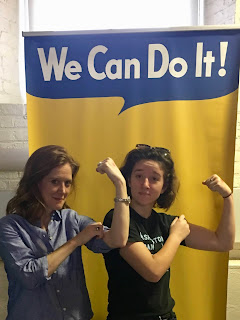The Only Thing Constant in Life is Change
Colonel Candid here starting this mentorship session with an adage my grandmother used to tell me. She served as a Women Accepted for Volunteer Emergency Service (WAVE) in World War II, for the Navy. It was a part of her history that I didn’t really know much about until I’d started serving in the military myself. I’d hear people referencing one of Grandma Bunny’s (yes, a former WAVE went by Bunny – short for Bernita) quotable quotes, “The only thing constant in life is change.” There’s a lot to unpackage in that statement but it does ring true. Let’s focus on leading in a time of change. More than likely, that’s what you’ll be doing and it’s best to have a clear path forward rather than fumble along.
The likelihood of success increases through preparing, fulfilling, and maintaining change by the following:
1. Stickiness. Don’t just throw change spaghetti at the wall and see what sticks. When you announce and change and expect people to just pick up on it, you’re in for some harsh reality. People are comfortable where they are, that’s why it’s called a comfort zone. Operationalization for change happens when you go beyond talking about it and doing something with it. Roll up your sleeves and start digging, this change won’t happen on its own.
2. Mapping. If you want people to go in a certain direction, give them at least a vector on which to travel. If you’re really interested in moving a project or organization show people the roadmap. You’ll not need to detail every pit stop but they’ll appreciate knowing you’re moving east when they were thinking you’d like to head west.
3. Stakeholder Acknowledgement. Employees want to provide feedback and have their voices be heard. That requires addressing employee concerns. To get a real commitment you need about 10-15% of your team committed to make the change. This initial tipping point is critical to success, without it you’re fighting an uphill battle.
4. Onboard Early Adopters. About to geek out a little here but let’s pay attention to Dr. Everett M. Rogers Diffusion of Innovations when he wrote about innovation, new ideas, and technology. You’re going to have the 2% who are immediately in agreement with all your ideas, regardless of the change or direction. You need to look at the theory of diffusion of innovations because it’s telling on how to get to the next 13% of early adopters, or people who are the first to buy into a product. Your product is the change and you can use this classic work to spark your mindset on how to think about leveraging employee knowledge and involving them in this change.
5. Confidently Communicate. If there is ever a time to bring out your optimistic self, this is it. You need to get into the head of your target audience and give them a compelling reason to change. If you really know your people, which I’m sure you do, figure out how to best sell this change in the terms and ways that energize them.
6. Excitement. You can start with motivation and working towards talking about that impetus for change. People are motivated by what we see and feel. Charge yourself and others up with visuals demonstrating the how and why. Play some music like, “Today My Life Begins” by Bruno Mars, “Don’t Worry Be Happy” by Bobby McFerrin, and “Walking On Sunshine” by Katrina & The Waves. Cheesy? Maybe, but you’ve got to over communicate and holistically demonstrate your optimism for this change.
Your team is now ready to chart a new course and make critical changes. Deliberate planning, with a touch of magnetism to make a change, goes a long way. Remember, you’ve got this and find your greatness this day and every day.



Comments
Post a Comment